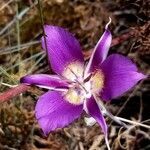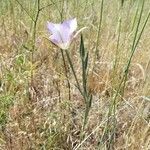A bulb plant. It is a herb that keeps growing from year to year. It has a bulb that tapers and is deep in the ground. The leaves are grass-like and blue-green. The leaves wither before the plant flowers. The stem is erect and usually unbranched. The flowers are pink and have 3 petals. The flowers can be 5 cm across. They can occur singly or as 2 or 3 at the top of the stem. The petals have a green stripe along them. There is also usually a dark purple band across them. The seed capsules are erect, narrow and taper.



